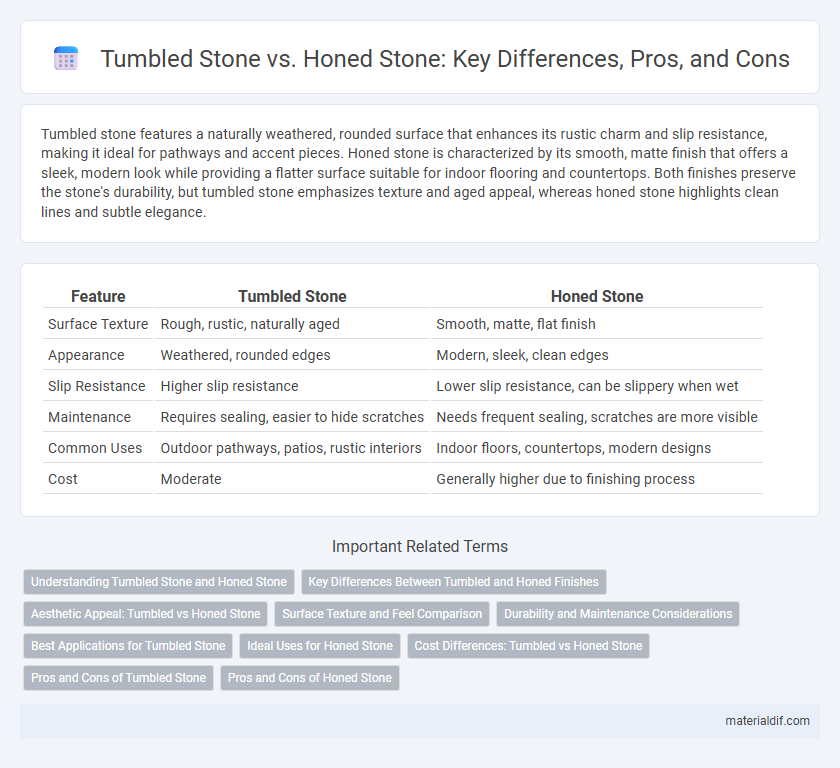Tumbled stone features a naturally weathered, rounded surface that enhances its rustic charm and slip resistance, making it ideal for pathways and accent pieces. Honed stone is characterized by its smooth, matte finish that offers a sleek, modern look while providing a flatter surface suitable for indoor flooring and countertops. Both finishes preserve the stone's durability, but tumbled stone emphasizes texture and aged appeal, whereas honed stone highlights clean lines and subtle elegance.
Table of Comparison
| Feature | Tumbled Stone | Honed Stone |
|---|---|---|
| Surface Texture | Rough, rustic, naturally aged | Smooth, matte, flat finish |
| Appearance | Weathered, rounded edges | Modern, sleek, clean edges |
| Slip Resistance | Higher slip resistance | Lower slip resistance, can be slippery when wet |
| Maintenance | Requires sealing, easier to hide scratches | Needs frequent sealing, scratches are more visible |
| Common Uses | Outdoor pathways, patios, rustic interiors | Indoor floors, countertops, modern designs |
| Cost | Moderate | Generally higher due to finishing process |
Understanding Tumbled Stone and Honed Stone
Tumbled stone features a textured, weathered surface achieved through mechanical tumbling, offering a rustic and natural appearance ideal for outdoor landscaping and decorative uses. Honed stone presents a smooth, matte finish created by grinding the surface until it is flat and polished but not glossy, making it suitable for interior applications like countertops and flooring where a sleek, modern aesthetic is desired. Both finishes influence the stone's slip resistance, maintenance requirements, and visual appeal, with tumbled stone providing more grip and honed stone offering a more refined look.
Key Differences Between Tumbled and Honed Finishes
Tumbled stone features a textured, rounded surface achieved through mechanical tumbling, enhancing its rustic and natural appearance, while honed stone has a smooth, matte finish created by grinding and polishing, offering a sleek and modern look. Tumbled finishes provide better slip resistance, making them ideal for high-traffic or outdoor areas, whereas honed stones are easier to clean and maintain but may show scratches more readily. The choice between tumbled and honed stone affects durability, aesthetic appeal, and suitability for specific applications such as flooring, countertops, or wall cladding.
Aesthetic Appeal: Tumbled vs Honed Stone
Tumbled stone features a rustic, weathered look with softened edges and a textured surface that enhances natural variations in color and pattern, creating a warm, aged aesthetic ideal for traditional or outdoor settings. Honed stone offers a smooth, matte finish with a sleek, modern appearance that highlights the stone's true color and veining without reflections or gloss, perfect for contemporary interiors. The choice between tumbled and honed stone significantly impacts the overall design vibe, balancing between organic charm and refined elegance.
Surface Texture and Feel Comparison
Tumbled stone features a rough, weathered surface with natural imperfections, creating a rustic and textured feel ideal for outdoor and casual designs. Honed stone offers a smooth, matte finish with minimal sheen, providing a sleek, modern touch while maintaining a non-slip surface suitable for indoor flooring and countertops. The distinct surface texture and tactile experience of each stone type influence their functionality and aesthetic application in architectural and design projects.
Durability and Maintenance Considerations
Tumbled stone features a textured, weathered surface making it more resistant to scratches and slip-prone areas, ideal for outdoor use with moderate maintenance involving regular sealing to prevent staining. Honed stone offers a smooth, matte finish that can be more susceptible to scratches and etching, requiring careful cleaning with pH-neutral products and frequent sealing to maintain durability. Choosing between tumbled and honed stone depends heavily on the intended environment and willingness to commit to routine maintenance for preserving aesthetic appeal and structural integrity.
Best Applications for Tumbled Stone
Tumbled stone features a weathered, natural texture ideal for outdoor landscaping, walkways, and rustic interior designs where slip resistance and character are essential. Its softened edges and matte finish make it perfect for spaces requiring a vintage or aged appearance, such as garden paths, patios, and fireplace surrounds. Tumbled stone's durability and grip also suit high-traffic areas like entryways and pool decks, enhancing both safety and aesthetic appeal.
Ideal Uses for Honed Stone
Honed stone features a smooth, matte finish that is ideal for interior applications where slip resistance and reduced glare are important, such as bathroom floors, kitchen countertops, and wall cladding. This finish enhances the natural color and texture of materials like limestone, marble, and granite, making it suitable for contemporary and minimalist design aesthetics. Its low-reflective surface also minimizes fingerprints and scratches, promoting durability in high-traffic areas.
Cost Differences: Tumbled vs Honed Stone
Tumbled stone generally costs more than honed stone due to the additional labor-intensive process required to create its textured, weathered finish. Honed stone features a smooth, matte surface achieved through polishing, which tends to involve less manual work, making it more cost-effective. The price variation also depends on stone type and sourcing, but tumbled finishes typically add 10-30% to the base cost of honed stone.
Pros and Cons of Tumbled Stone
Tumbled stone offers a rustic, aged appearance with a textured, non-slip surface ideal for outdoor use or high-traffic areas, providing durability and enhanced grip. However, the rough finish can make cleaning more challenging, and the uneven texture may trap dirt or debris compared to the smooth, polished surface of honed stone. While tumbled stone excels in aesthetic warmth and practicality, it may require more maintenance to preserve its natural look.
Pros and Cons of Honed Stone
Honed stone offers a smooth, matte finish that enhances slip resistance and hides scratches better than polished surfaces, making it ideal for high-traffic areas and floors. However, its lack of shine can make colors appear muted, and it may require more frequent cleaning to maintain its appearance, as stains can be less visible but harder to remove. The durability of honed stone varies by material, with softer stones prone to wear and etching over time compared to harder options like granite.
Tumbled Stone vs Honed Stone Infographic

 materialdif.com
materialdif.com